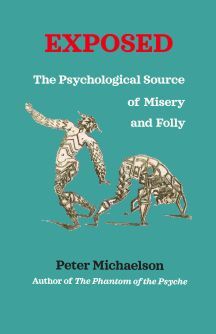How We Spook, Spoof, and Gaslight Ourselves
I’ve just published my latest book, and it may be my best effort yet in exposing and explaining the hidden dynamics in our psyche that undermine our health and happiness. It’s titled, Exposed: The Psychological Source of Misery and Folly. This is indeed a bold name for a book, but its groundbreaking knowledge merits the title. (It’s here at Amazon.com as a paperback or e-book.)
 This is my tenth book that plumbs the depths of our amazing psyche, and it packages all the others in an edifying 240 pages. This writing is hard work. It’s somewhat like writing code. A precision of language is needed to illuminate the pranks and capers of our unconscious mind. Precision is required to expose the unconscious sedition in our psyche that falsifies reality and betrays our conscious aspirations. Each word toils for traction and lurches for lucidity as it spins in our psyche’s turbulent underworld.
This is my tenth book that plumbs the depths of our amazing psyche, and it packages all the others in an edifying 240 pages. This writing is hard work. It’s somewhat like writing code. A precision of language is needed to illuminate the pranks and capers of our unconscious mind. Precision is required to expose the unconscious sedition in our psyche that falsifies reality and betrays our conscious aspirations. Each word toils for traction and lurches for lucidity as it spins in our psyche’s turbulent underworld.
It may be the last such book I’ll write. I don’t think I can present this psychological knowledge any more clearly.
Exposed describes in detail how unconsciously—or as I often say, unwittingly—we make choices that plunge us into misery where we tend to wallow in mediocrity and self-pity. Our lack of self-knowledge makes us pushovers who topple into emotional suffering and behavioral self-defeat. Growing self-knowledge brings this weakness into focus. As we see the nature and dynamics of this inner weakness, we acquire the wisdom and strength to break free from needless suffering.
We recognize with new clinical intelligence our propensity for recycling and replaying, in everyday situations, the unresolved hurts that have lingered in our psyche since childhood. These eight hurts are feeling deprived, refused, controlled, helpless, criticized, rejected, betrayed, and abandoned. Typically, we are unaware of our readiness to jump into this old, familiar dissonance to jitterbug with the blues.
These eight first hurts are processed through inner conflict that is mostly unconscious. This inner conflict is energized by a primitive inner critic (superego) that batters our defensive, passive unconscious ego. When our growing insight and invigorated intelligence penetrate this unconscious ego’s realm, we recognize the lack of consciousness there that has allowed the superego, an agent of self-aggression, to intrude so insensitively into our mind, stirring up irrationality and self-punishment. Now we see with liberating clarity how we have been allowing ourselves to be spooked, spoofed, and gaslighted by both the aggressive side and the defensive side of inner conflict.
As I say in the book, “We all deal with a major inner conflict between our conscious wish to feel strong, worthy, and lovable versus our unconscious tendency to go on experiencing ourselves as weak, unworthy, and unlovable. This conflict can heat up daily as our inner thoughts, in wearisome futility, debate our faults versus our merits. Even when entangled in such conflict, we seldom bring it into focus. We get personally entangled in the conflict, and we don’t see the conflict objectively as a compulsive inner program that just scoops up unresolved emotional content from our life in order to maintain itself.”
Inner conflict is an irrational, authoritarian system of government operating inside us. When we illuminate the source of our self-ignorance, we liberate ourselves from the tyranny of inner conflict. We also help the world to outgrow cruelty, stupidity and evil. Saving democracy, saving the world, saving ourself, it’s all the same thing—and it all starts in our psyche.
—
Again, the book is available here. Please consider leaving a comment or review.
.huge-it-share-buttons {
border:0px solid #0FB5D6;
border-radius:5px;
background:#3BD8FF;
text-align:left; }
#huge-it-share-buttons-top {margin-bottom:0px;}
#huge-it-share-buttons-bottom {margin-top:0px;}
.huge-it-share-buttons h3 {
font-size:25px ;
font-family:Arial,Helvetica Neue,Helvetica,sans-serif;
color:#666666;
display:block; line-height:25px ;
text-align:left; }
.huge-it-share-buttons ul {
float:left; }
.huge-it-share-buttons ul li {
margin-left:3px;
margin-right:3px;
padding:0px;
border:0px ridge #E6354C;
border-radius:11px;
background-color:#14CC9B;
}
.huge-it-share-buttons ul li #backforunical2977 {
border-bottom: 0;
background-image:url('https://whywesuffer.com/wp-content/pl...
width:30px;
height:30px;
}
.front-shares-count {
position: absolute;
text-align: center;
display: block;
}
.shares_size20 .front-shares-count {
font-size: 10px;
top: 10px;
width: 20px;
}
.shares_size30 .front-shares-count {
font-size: 11px;
top: 15px;
width: 30px;
}
.shares_size40 .front-shares-count {
font-size: 12px;
top: 21px;
width: 40px;
}
Share This:
Peter Michaelson's Blog
- Peter Michaelson's profile
- 9 followers



